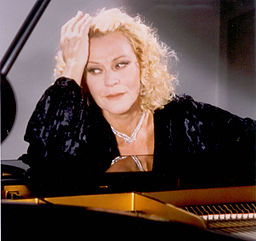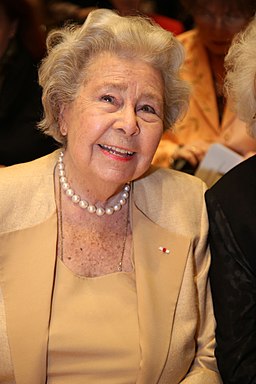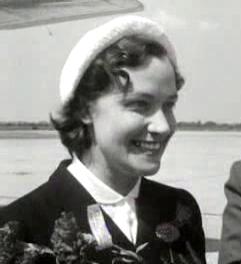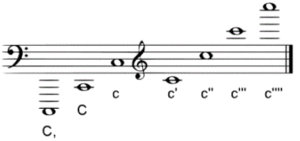There are four vocal categories for the lower female voice in the Fach system. Here they are separated into the Seriöserfächer and the Spiel- and Charakterfächer. Follow the links to an extensive listing of typical roles and audition arias.
Part one: Spiel- und (and) Charakterfach: [ʃpi:l ʊnt ka.’ʁak.tɐ ‘fax]
 Spielalt (Lyrischer Mezzosopran) [‘ʃpi:l.’alt ‘ly:.ʁɪ.ʃɐ.’mɛd.zo.so.’pʁan] (f–b”):
Spielalt (Lyrischer Mezzosopran) [‘ʃpi:l.’alt ‘ly:.ʁɪ.ʃɐ.’mɛd.zo.so.’pʁan] (f–b”):
- A supple voice capable of fine characterization; a versatile actress.
Although the name Lyrischer Mezzosopran would lead one to believe that this Fach belongs to the Seriöser Fach, the older name of Spielalt better describes his voice in relation to the other vocal categories. She is the mezzo counterpart of the Soubrette. Her voice is a flexible, mellow instrument lacking the metallic ring and broad legato line. Her vocal color in the German theater can often be rather light, sounding much like a soprano. She should look good in pants and be willing to sing quite a few roles of lesser importance.
The important roles for a Lyrischer Mezzosopran are Cherubino in Le nozze di Figaro, the Komponist in Ariadne auf Naxos, and Rosina in Il barbiere di Siviglia. Although a Lyrischer Mezzosopran with a fuller voice may use the Carmen arias in audition, she rarely sings this role in a full production.
Singers: Frederica von Stade, Lucia Valentini-Ferrani, Cecilia Bartoli, Jennifer Larmore, Suzanne Mentzer, and Theodora Hanslowe.
Examples: Frederica von Stade in Semiramide; Lucia Valentini-Ferrani in La Cenerentola.
Spielalt roles and arias.
 Part two: Seriöser Fächer [ze.ʁi.’ø:.zɐ ‘fɛ:.çɐ]
Part two: Seriöser Fächer [ze.ʁi.’ø:.zɐ ‘fɛ:.çɐ]
Dramatischer Mezzosopran [dʁa.’ma:.tɪ.ʃɐ ‘mɛd.zo.so.’pʁan] (g–b” and c”‘):
- Flexible, metallic Zwischenfach voice with a dark color and excellent top voice that often matures into the Hochdramatic Fach.
The Dramatischer Mezzosopran sings some of the meatiest roles in all of opera. The title role in Carmen, Eboli in Don Carlo, Amneris in Aïda, Octavian in Der Rosenkavalier, and Fricke in Die Walküre are hers. Being a Zwischenfach voice means she is capable of both a long lyric lines as well as dramatic moments. Her roles demand great physical beauty and vocal power, and the ability to hold the stage alone with authority.
Singers: Fiorenza Cassotto, Christa Ludwig, Rise Stevens, Giulietta Simionato, Tatiana Troyanos, Maria Ewing, Marilyn Horne.
Examples: Fiorenza Cassotto in Le nozze di Figaro; Christa Ludwig in Des Knaben Wunderhorn.
Dramatischer Mezzosopran roles and arias
Dramatischer Alt [dʁa.’ma:.tɪ.ʃɐ ʔalt] (g-b”):
- Flexible, metallic voice with both a well-developed high and low voice; capable of dramatic penetration.
The Dramatischeralt is the true dramatic among the lower women’s voices and often sings the roles of the Tieferalt. It is a Fach generally reserved for the more mature singer. In addition to the dramatic roles of Ulrica in Un ballo in maschera, Azucena in Il trovatore, and Herodias in Salome, she sings many smaller roles demanding fine characterization.
Singers: Francis Bible, Christa Ludwig, Brigitte Fassbander, Waltraud Meier, Ebe Stignani, Fedora Barbieri, Fiorenza Cassotto, Shirley Verrett, Grace Bumbry, and Dolora Zaxick.
Examples: Francis Bible in The Ballad of Baby Doe.
Dramatischer Alt roles and arias.
 Tiefer Alt (Kontra-Alt) [‘ti:.fɐ ʔalt ‘kɔn.tʁə ʔalt] (f-a”):
Tiefer Alt (Kontra-Alt) [‘ti:.fɐ ʔalt ‘kɔn.tʁə ʔalt] (f-a”):
- Full, rich voice with a comfortable low voice.
This is a rather special category and an important one. While it can include the great roles listed for the Dramatischeralt, it contains many roles demanding an extensive low voice and a mature appearance. In this Fach we find the roles of Zita in Gianni Schicchi, Erda in Das Rheingold, Dame Quickly in Falstaff and the Dritte Dame (Third Lady) in Die Zauberflöte.
Singers: Florence Quivar, Kathleen Ferrier.
Example: Marga Hoffgen in Das Rheingold.
Tiefer Alt roles and arias.
______________________________________
Helmholz notation:

(This article is the fifth part in the series on the German Fach System and is based on information derived from Rudolf Kloiber’s “Handbuch der Oper”, 9th edition, Deutschen Taschenbuch Verlag. Read the first part of this series here.)
